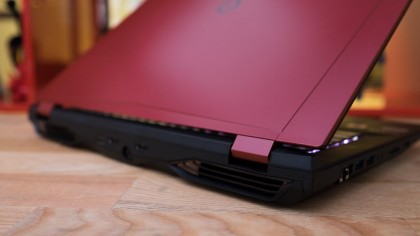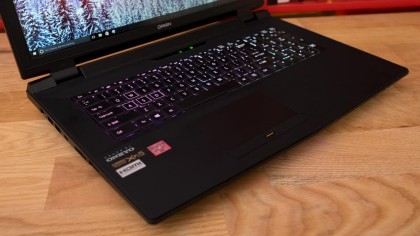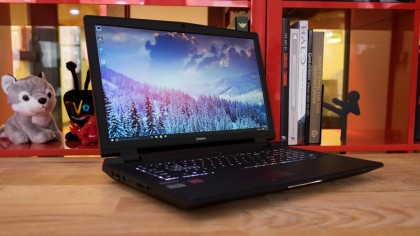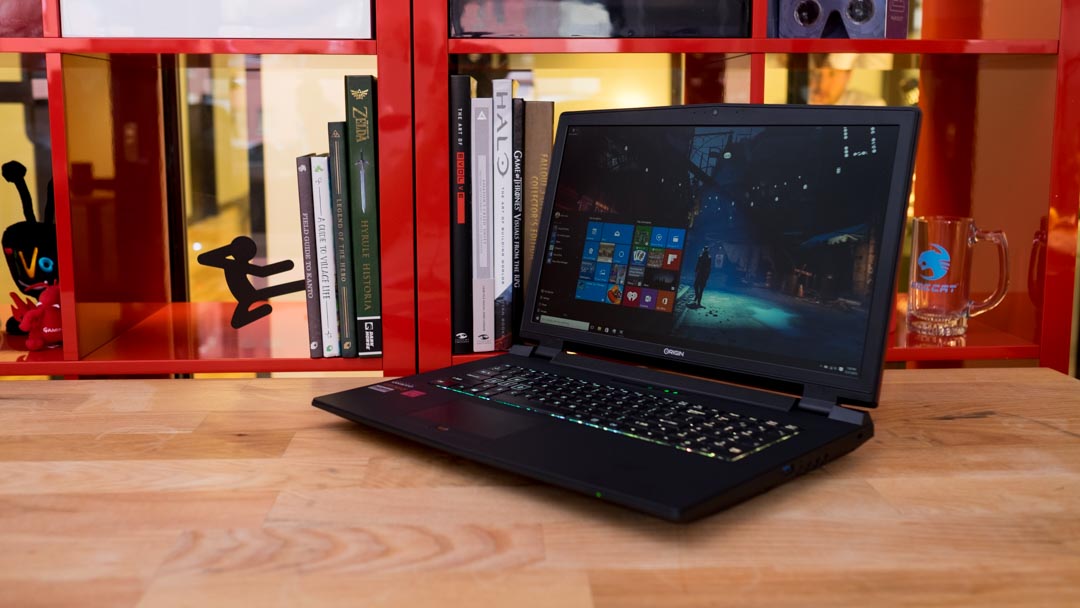Why you can trust TechRadar
Whereas using the Origin EON15-X felt like using a big laptop, the EON17-X feels more a desktop I can fold and pack away. The larger 17-inch display makes split-screen multitasking a realistic pursuit.
As a result, the physical presence of this huge device makes it feel like I am resting a computing platform on my lap rather than a portable notebook. Unfortunately, the performance jump going from Haswell to Skylake processors isn't as impressive.

Benchmarks
Here's how the Origin EON17-X performed in our suite of benchmark tests:
- 3DMark: Cloud Gate: 28,335; Sky Diver: 24,992; Fire Strike: 8,811
- Cinebench CPU: 878 points; Graphics: 131 fps,
- GeekBench: 4,319 (single-core); 16,921 (multi-core)
- PCMark 8 (Home Test): 4,703 points
- PCMark 8 Battery Life: 2 hours and 17 minutes
- Middle Earth: Shadow of Mordor (1080p, Ultra): 73 fps; (1080p, Low): 163 fps
- Metro: Last Light (1080p, Ultra): 39 fps; (1080p, Low): 154 fps
That's not to say there's no improvement at all. The Origin EON17-X scored a few extra points in the PCMark 8 score, which translates to your video rendering a little bit faster in real world usage.
The laptop was also able to achieve a slightly higher frame rate while playing Shadow of Mordor on Ultra for smoother gameplay. For a better look, here's how the Haswell-powered EON15-X performed in our benchmark tests:
- 3DMark: Cloud Gate: 27,405; Sky Diver: 24,414; Fire Strike: 8,788
- Cinebench CPU: 874 points; Graphics: 158 fps,
- PCMark 8 (Home Test): 4,697 points
- PCMark 8 Battery Life: 2 hours and 4 minutes
- Middle Earth: Shadow of Mordor (1080p, Ultra): 69 fps; (1080p, Low): 161 fps
- Metro: Last Light (1080p, Ultra): 36 fps; (1080p, Low): 138 fps

While the year to year change in performance between desktop processors isn't too astonishing, the EON17-X still floors most other gaming laptops. Just looking at the PCMark scores, Origin's 17-inch monster dominates the Alienware 17's 3,225-point performance and the 4,093 score put forth by the Aorus X7 Pro.
In terms of gaming, the Origin's latest lags behind a bit. The EON17-X was able to play Shadow of Mordor at a more than decent 69 frames per second (fps) on Ultra, which is a tad better than the Alienware 17's 64 fps performance but the Aorus is on top, pushing 85 fps. With the added boost from the Graphics Amplifier, the Alienware 17 is almost as much of a gaming powerhouse as the Aorus X7. But, in a race for graphical supremacy, the EON17-X unsurprisingly comes in last.
That said, Origin also has another EON17-SLX model that utilizes both a desktop-class Intel Skylake processor and Nvidia GTX 980, which is arguably the ultimate desktop replacement machine.
Still, you'll have more than enough firepower to plow through most games with the EON17-X. I was able to play Fallout 4 at a steady 60 fps with a bunch of added mods and the display settings turned up to Ultra. The EON17-X even had zero problems running the recent (buggy) release of Just Cause 3 at an unfaltering 60 fps.

Power hog
Unsurprisingly, battery life is also not the EON17-X's forte. The 17-inch Origin lasted only 2 hours and 4 minutes while running the PCMark 8 battery test. Still, that's a few minutes longer than the Aorus X7 Pro's 1 hour and 53 minute runtime. Meanwhile, the Alienware 17 was finished after a comparatively lengthy 3 hours and 33 minutes.
The EON17-X managed to only hang on for five minutes longer while playing Guardians of the Galaxy in a constant loop at 50% screen brightness and volume. In real world usage (a mix of internet browsing, music streaming and word processing), the desktop CPU-powered rig ran for a maximum of 2 hours and 45 minutes.
When you're buying a gaming notebook, long battery life probably isn't high on your list of priorities. However, it's worth noting you can get nearly four hours of usage out of the Alienware 17. The Aorus X7 Pro is the biggest battery hog in this pen, lasting at most for 2 hours and 5 minutes.
Bundled software
Origin has kept the amount of preloaded applications to a bare minimum, as most gamers reserve their SSD space for games. That said, there are still a few non-essential applications, and these are the main ones you'll want to keep around.
- SteelSeries Engine – An essential application for changing everything on the keyboard from macro shortcuts to all of the backlighting options.
- Sound Blaster Xi-fi MB5 – Tune your speaker setup or pick from a set of preset modes for different types of games.
- SpyderUtility – The package app that controls the screen calibration, though there's not much control, as it's locked into one profile setup that was created in the factory.
Kevin Lee was a former computing reporter at TechRadar. Kevin is now the SEO Updates Editor at IGN based in New York. He handles all of the best of tech buying guides while also dipping his hand in the entertainment and games evergreen content. Kevin has over eight years of experience in the tech and games publications with previous bylines at Polygon, PC World, and more. Outside of work, Kevin is major movie buff of cult and bad films. He also regularly plays flight & space sim and racing games. IRL he's a fan of archery, axe throwing, and board games.

